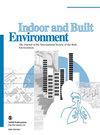Enhancing thermal comfort assessment: A sensitivity study of PMV-PPD and adaptive models in an Algerian reference hotel across different climate zones
IF 2.9
3区 工程技术
Q2 CONSTRUCTION & BUILDING TECHNOLOGY
引用次数: 0
Abstract
This study investigated the impact of design parameters on indoor thermal comfort in hotel buildings, using both PMV-PPD and adaptive models. The aim is to provide guidance for improvement in the energy performance and thermal comfort of the accommodation structures, providing analysis extended to the eight Algerian climate zones. The adopted methodology was applied to a reference building hotel in Ghardaïa, Algeria. The energy model was validated through in-situ measurements and then the analysis was extended through EnergyPlus dynamic simulations to assess the influence of 13 design parameters using sensitivity analysis. Results reveal that design temperatures on the hottest days ranged from 34.4°C to 39.3°C, despite external temperatures reaching 45°C. The PMV-PPD model was most affected by space density, ventilation rate, infiltration, ventilation schedules, roof design and azimuth. Conversely, the adaptive model was influenced primarily by ventilation rate, window-to-wall ratio, lighting, space density, ventilation schedules, glazing and azimuth. This study underscores the potential for optimising hotels’ design to enhance thermal comfort and has broader relevance for regions with similar climates to Algeria. The findings offer insights for creating more comfortable indoor environments and fostering sustainable building practices in challenging climates.加强热舒适度评估:不同气候区阿尔及利亚参考酒店 PMV-PPD 和自适应模型的敏感性研究
本研究采用 PMV-PPD 和自适应模型,调查了设计参数对酒店建筑室内热舒适度的影响。目的是为改善住宿建筑的能源性能和热舒适度提供指导,并提供阿尔及利亚八个气候区的分析。所采用的方法适用于阿尔及利亚 Ghardaïa 的参考建筑酒店。通过现场测量对能源模型进行了验证,然后通过 EnergyPlus 动态模拟对分析进行了扩展,利用敏感性分析评估了 13 个设计参数的影响。结果显示,尽管外部温度达到 45°C,但最热天的设计温度在 34.4°C 至 39.3°C 之间。PMV-PPD 模型受空间密度、通风率、渗透率、通风计划、屋顶设计和方位角的影响最大。相反,自适应模型主要受通风率、窗墙比、照明、空间密度、通风计划、玻璃和方位角的影响。这项研究强调了优化酒店设计以提高热舒适度的潜力,并对与阿尔及利亚气候相似的地区具有更广泛的意义。研究结果为在具有挑战性的气候条件下创造更舒适的室内环境和促进可持续建筑实践提供了启示。
本文章由计算机程序翻译,如有差异,请以英文原文为准。
求助全文
约1分钟内获得全文
求助全文
来源期刊

Indoor and Built Environment
环境科学-工程:环境
CiteScore
6.40
自引率
25.00%
发文量
130
审稿时长
2.6 months
期刊介绍:
Indoor and Built Environment publishes reports on any topic pertaining to the quality of the indoor and built environment, and how these might effect the health, performance, efficiency and comfort of persons living or working there. Topics range from urban infrastructure, design of buildings, and materials used to laboratory studies including building airflow simulations and health effects. This journal is a member of the Committee on Publication Ethics (COPE).
 求助内容:
求助内容: 应助结果提醒方式:
应助结果提醒方式:


